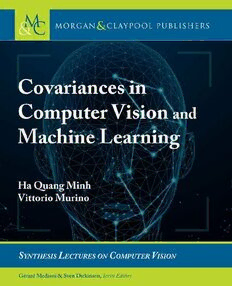
Covariances in Computer Vision and Machine Learning PDF
Preview Covariances in Computer Vision and Machine Learning
Covariances in Computer Vision and Machine Learning Synthesis Lectures on Computer Vision Editors GérardMedioni,UniversityofSouthernCalifornia SvenDickinson,UniversityofToronto SynthesisLecturesonComputerVisioniseditedbyGérardMedionioftheUniversityofSouthern CaliforniaandSvenDickinsonoftheUniversityofToronto.Theseriespublishes50–150page publicationsontopicspertainingtocomputervisionandpatternrecognition.Thescopewilllargely followthepurviewofpremiercomputerscienceconferences,suchasICCV,CVPR,andECCV. Potentialtopicsinclude,butnotarelimitedto: • ApplicationsandCaseStudiesforComputerVision • Color,Illumination,andTexture • ComputationalPhotographyandVideo • EarlyandBiologically-inspiredVision • FaceandGestureAnalysis • IlluminationandReflectanceModeling • Image-BasedModeling • ImageandVideoRetrieval • MedicalImageAnalysis • MotionandTracking • ObjectDetection,Recognition,andCategorization • SegmentationandGrouping • Sensors • Shape-from-X • StereoandStructurefromMotion • ShapeRepresentationandMatching iv • StatisticalMethodsandLearning • PerformanceEvaluation • VideoAnalysisandEventRecognition CovariancesinComputerVisionandMachineLearning HàQuangMinhandVittorioMurino 2017 ElasticShapeAnalysisofThree-DimensionalObjects IanH.Jermyn,SebastianKurtek,HamidLaga,andAnujSrivastava 2017 TheMaximumConsensusProblem:RecentAlgorithmicAdvances Tat-JunChinandDavidSuter 2017 ExtremeValueTheory-BasedMethodsforVisualRecognition WalterJ.Scheirer 2017 DataAssociationforMulti-ObjectVisualTracking MargritBetkeandZhengWu 2016 EllipseFittingforComputerVision:ImplementationandApplications KenichiKanatani,YasuyukiSugaya,andYasushiKanazawa 2016 ComputationalMethodsforIntegratingVisionandLanguage KobusBarnard 2016 BackgroundSubtraction:TheoryandPractice AhmedElgammal 2014 Vision-BasedInteraction MatthewTurkandGangHua 2013 CameraNetworks:TheAcquisitionandAnalysisofVideosoverWideAreas AmitK.Roy-ChowdhuryandBiSong 2012 v DeformableSurface3DReconstructionfromMonocularImages MathieuSalzmannandPascalFua 2010 Boosting-BasedFaceDetectionandAdaptation ChaZhangandZhengyouZhang 2010 Image-BasedModelingofPlantsandTrees SingBingKangandLongQuan 2009 Copyright©2018byMorgan&Claypool Allrightsreserved.Nopartofthispublicationmaybereproduced,storedinaretrievalsystem,ortransmittedin anyformorbyanymeans—electronic,mechanical,photocopy,recording,oranyotherexceptforbriefquotations inprintedreviews,withoutthepriorpermissionofthepublisher. CovariancesinComputerVisionandMachineLearning HàQuangMinhandVittorioMurino www.morganclaypool.com ISBN:9781681730134 paperback ISBN:9781681730141 ebook DOI10.2200/S00801ED1V01Y201709COV011 APublicationintheMorgan&ClaypoolPublishersseries SYNTHESISLECTURESONCOMPUTERVISION Lecture#13 SeriesEditors:GérardMedioni,UniversityofSouthernCalifornia SvenDickinson,UniversityofToronto SeriesISSN Print2153-1056 Electronic2153-1064 Covariances in Computer Vision and Machine Learning Hà Quang Minh IstitutoItalianodiTecnologia Vittorio Murino IstitutoItalianodiTecnologia and UniversityofVerona SYNTHESISLECTURESONCOMPUTERVISION#13 M &C Morgan&cLaypool publishers ABSTRACT Covariancematricesplayimportantrolesinmanyareasofmathematics,statistics,andmachine learning, as well as their applications. In computer vision and image processing, they give rise to a powerful data representation, namely the covariance descriptor, with numerous practical applications. Inthisbook,webeginbypresentinganoverviewofthefinite-dimensionalcovariancema- trixrepresentationapproachofimages,alongwithitsstatisticalinterpretation.Inparticular,we discussthevariousdistancesanddivergencesthatarisefromtheintrinsicgeometricalstructures of the set of Symmetric Positive Definite (SPD) matrices, namely Riemannian manifold and convex cone structures. Computationally, we focus on kernel methods on covariance matrices, especiallyusingtheLog-Euclideandistance. We then show some of the latest developments in the generalization of the finite- dimensionalcovariancematrixrepresentationtotheinfinite-dimensionalcovarianceoperatorrep- resentation via positive definite kernels. We present the generalization of the affine-invariant RiemannianmetricandtheLog-Hilbert-Schmidtmetric,whichgeneralizestheLog-Euclidean distance.Computationally,wefocusonkernelmethodsoncovarianceoperators,especiallyusing the Log-Hilbert-Schmidt distance. Specifically, we present a two-layer kernel machine, using theLog-Hilbert-Schmidtdistanceanditsfinite-dimensionalapproximation,whichreducesthe computationalcomplexityoftheexactformulationwhilelargelypreservingitscapability.The- oretical analysis shows that, mathematically, the approximate Log-Hilbert-Schmidt distance should be preferred over the approximate Log-Hilbert-Schmidt inner product and, computa- tionally,itshouldbepreferredovertheapproximateaffine-invariantRiemanniandistance. Numericalexperimentsonimageclassificationdemonstratesignificantimprovementsof theinfinite-dimensionalformulationoverthefinite-dimensionalcounterpart.Giventhenumer- ous applications of covariance matrices in many areas of mathematics, statistics, and machine learning, just to name a few, we expect that the infinite-dimensional covariance operator for- mulationpresentedherewillhavemanymoreapplicationsbeyondthoseincomputervision. KEYWORDS covariance descriptors in computer vision, positive definite matrices, infinite- dimensional covariance operators, positive definite operators, Hilbert-Schmidt operators, Riemannian manifolds, affine-invariant Riemannian distance, Log- Euclidean distance, Log-Hilbert-Schmidt distance, convex cone, Bregman diver- gences,kernelmethodsonRiemannianmanifolds,visualobjectrecognition,image classification
